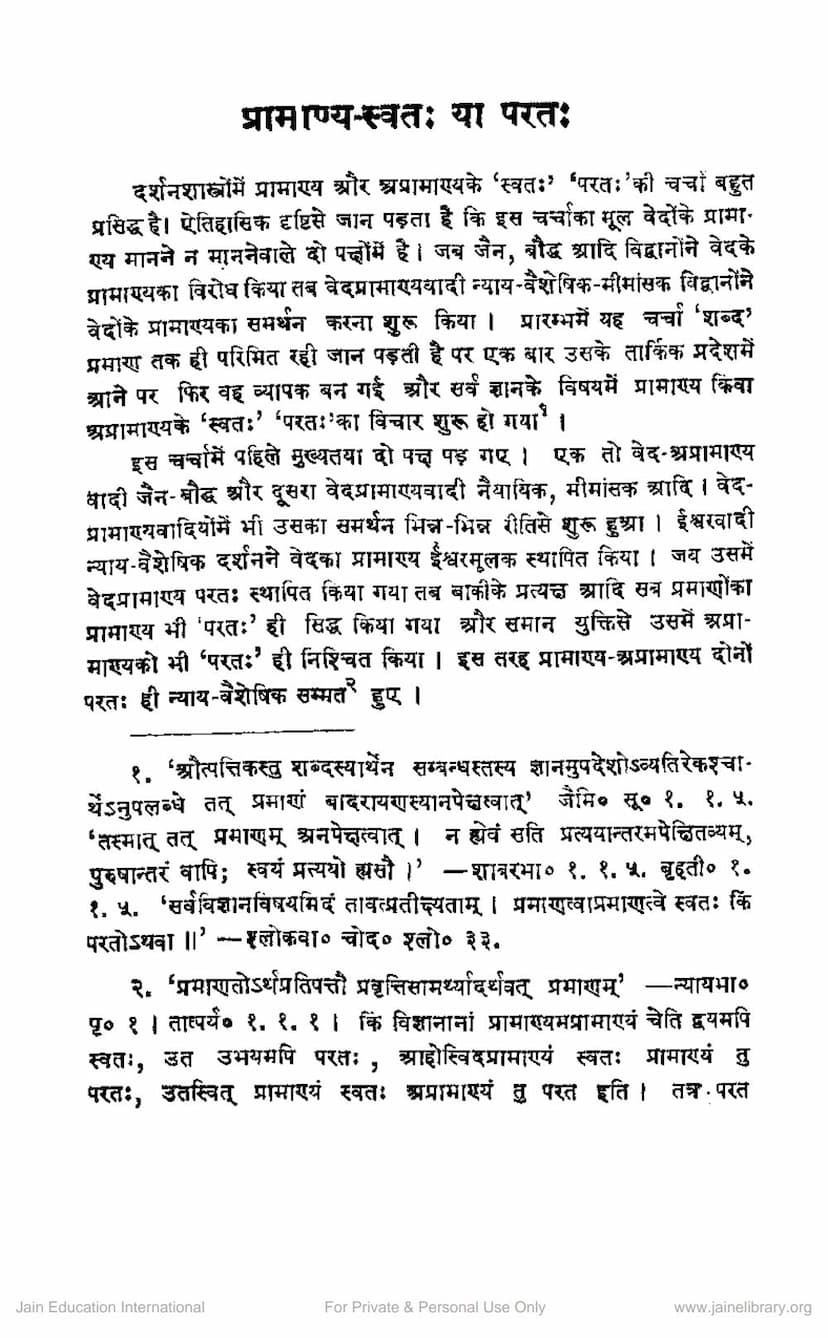Pramanya Swata Ya Parata
Added to library: September 2, 2025

Summary
Here's a comprehensive summary of the provided Jain text, "Pramanya Swata ya Parata" by Sukhlal Sanghavi, focusing on the philosophical concepts discussed:
The text "Pramanya Swata ya Parata" by Sukhlal Sanghavi delves into a fundamental and widely debated topic in Indian philosophy: the nature of validity (pramanya) and invalidity (apramanya) of knowledge, specifically whether it is intrinsic (svatah) or extrinsic (paratah).
Historical Context of the Debate:
- The discussion historically originated from the differing views on the validity of the Vedas.
- When Jain and Buddhist scholars challenged the authority of the Vedas, Vedic proponent schools like Nyaya, Vaisheshika, and Mimamsa defended their validity.
- Initially, this debate was limited to the pramana (means of knowledge) of testimony (shabda). However, once it entered the realm of logic, it expanded to encompass the validity and invalidity of all forms of knowledge.
The Four Main Schools of Thought on Pramanya/Apramanya:
The text outlines four primary positions that emerged from this debate regarding whether the validity/invalidity of knowledge is intrinsic or extrinsic:
- Both Pramanya and Apramanya are Svatah (Intrinsic): This view holds that the validity and invalidity of knowledge are inherent to the knowledge itself.
- Both Pramanya and Apramanya are Paratah (Extrinsic): This view asserts that both validity and invalidity depend on something external to the knowledge.
- Pramanya is Svatah, and Apramanya is Paratah: This position argues that valid knowledge is intrinsically valid, while invalid knowledge is invalidated by external factors.
- Apramanya is Svatah, and Pramanya is Paratah: This is the opposite of the previous view, suggesting that invalid knowledge is intrinsically invalid, while valid knowledge derives its validity from an external source.
Views of Different Philosophical Schools:
- Nyaya-Vaisheshika: These schools, being theistic, established the validity of the Vedas as being paratah (extrinsic), rooted in God. Consequently, they also argued that the validity of all other means of knowledge (like perception) is paratah, and similarly, their invalidity is also paratah. Thus, Nyaya-Vaisheshika generally accepts both validity and invalidity as extrinsic.
- Mimamsa: Unlike the Nyaya-Vaisheshika, the Mimamsa school is not theistic. Therefore, they could not attribute the validity of the Vedas to God. Instead, they declared the validity of the Vedas to be svatah (intrinsic). To support this, they also asserted that the validity of all other means of knowledge (like perception) is svatah. However, they maintained that invalidity is paratah (extrinsic).
- Samkhya: While direct textual evidence from Samkhya is scarce, based on the statements of scholars like Kumarila, Shantarakshita, and Madhavacharya, it appears that the Samkhya school believed both pramanya and apramanya are svatah.
- A Counter-Mimamsa View (Possibly Buddhist): Some scholars mention a position that is the direct opposite of the Mimamsa view, asserting that apramanya is svatah and pramanya is paratah. While "Sarvadarshana-Sangraha" attributes this to the Bauddha school, the text notes that the Buddhist position discussed in "Tarkasangraha" is entirely different. It is suggested that this specific view might have belonged to a particular Buddhist thinker.
- Shantarakshita's (Buddhist) View: Shantarakshita, a prominent Buddhist philosopher, clarified that none of the four rigid positions mentioned above are strictly held by the Buddhists. He emphasized that the Buddhist position is "aniyamavadi" (non-deterministic or irregular). This means that for Buddhists, both validity and invalidity can be svatah (intrinsic) or paratah (extrinsic) in an irregular manner. Specifically, they hold that in the stage of practice (abhyasa-dasha), both validity and invalidity are considered svatah, while in the stage of non-practice (anabhyaasa-dasha), they are considered paratah.
- Jain Tradition's View: The Jain tradition aligns closely with the nuanced Buddhist position described by Shantarakshita. The Jain approach, as clearly stated in the "Pramananayatattvaloka," also maintains that both pramanya and apramanya are svatah in the stage of practice, and paratah in the stage of non-practice. Although Acharya Hemachandra, in his "Pramukhasutra," only explicitly discusses the svatah-paratah of pramanya (similar to "Parikshamuha"), the detailed exposition in Devsurika's commentary fully reflects the Jain tradition.
Evolution of the Debate:
The discussion of "svatah-paratah" has evolved significantly over time. It has expanded to incorporate considerations of origination (utpatti), ascertainment (shakti/nishchaya), and functioning (pravritti). This makes the svatah-paratah debate a crucial and indispensable topic in all philosophical systems, leading to the development of complex and profound works like "Tattvachintamani" and "Gagadadhara Pramanyavada."
In essence, the text "Pramanya Swata ya Parata" meticulously traces the historical development and diverse interpretations of the fundamental philosophical question of how knowledge derives its validity and invalidity, highlighting the unique contributions and nuances of various Indian philosophical schools, particularly the Jain perspective.